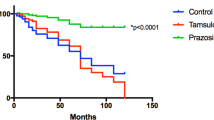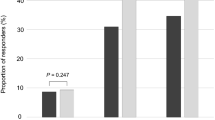Abstract
Background:
To assess the efficacy and safety of LY500307, a selective estrogen receptor beta agonist, on lower urinary tract symptoms (LUTS) in patients with enlarged prostate secondary to BPH.
Methods:
In a randomized, double-blind, placebo-controlled, parallel phase 2, efficacy and safety study, eligible patients with moderate to severe LUTS and prostatic enlargement (⩾30 ml) were randomized to placebo or LY500307 at 1, 3, 10 and 25 mg once daily for 24 weeks. Primary efficacy end point was change in total International Prostate Symptoms Score (IPSS) after 24 weeks. Secondary end points included changes in total prostate volume (TPV) that served as a proof of concept end point, as well as IPSS quality of life, maximum peak urine flow rate (Qmax) and PSA and safety (adverse events, laboratory test).
Results:
A total of 414 patients were randomized when the study was terminated because of insufficient TPV reduction, based on a priori defined interim analysis. The IPSS mean change from baseline to end point was −3.4±6.8 in the placebo group and −1.3±6.6, −2.6±7.0, −3.7±6.7 and −4.4±5.7 in the 1, 3, 10 and 25 mg LY500307-treated groups, respectively (P>0.05). Similarly, no treatment effect was observed for any of the secondary efficacy measures. Incidence of adverse events was comparable between treatment groups, and no clinically meaningful changes in laboratory tests were observed.
Conclusions:
LY500307 was well tolerated in BPH patients with LUTS at doses up to 25 mg once daily for 24 weeks. The study was terminated early because of inadequate efficacy.
This is a preview of subscription content, access via your institution
Access options
Subscribe to this journal
Receive 4 print issues and online access
$259.00 per year
only $64.75 per issue
Buy this article
- Purchase on Springer Link
- Instant access to full article PDF
Prices may be subject to local taxes which are calculated during checkout



Similar content being viewed by others
References
Roehrborn CG . Pathology of benign prostatic hyperplasia. Int J Impot Res 2008; 20: S11.
McConnell JD, Roehrborn CG, Bautista OM, Andriole GL Jr, Dixon CM, Kusek JW et al. The long-term effect of doxazosin, finasteride, and combination therapy on the clinical progression of benign prostatic hyperplasia. N Engl J Med 2003; 349: 2387.
Weihua Z, Lathe R, Warner M, Gustafsson JA . An endocrine pathway in the prostate, ERbeta, AR, 5alpha-androstane-3beta,17beta-diol, and CYP7B1, regulates prostate growth. Proc Natl Acad Sci USA 2002; 99: 13589.
Martin C, Ross M, Chapman KE, Andrew R, Bollina P, Seckl JR et al. CYP7B generates a selective estrogen receptor beta agonist in human prostate. J Clin Endocrinol Metab 2004; 89: 2928.
Imamov O, Morani A, Shim GJ, Omoto Y, Thulin-Andersson C, Warner M et al. Estrogen receptor beta regulates epithelial cellular differentiation in the mouse ventral prostate. Proc Natl Acad Sci USA 2004; 101: 9375.
Alonso-Magdalena P, Brössner C, Reiner A, Cheng G, Sugiyama N, Warner M et al. A role for epithelial-mesenchymal transition in the etiology of benign prostatic hyperplasia. Proc Natl Acad Sci USA 2009; 106: 2859.
Norman BH, Dodge JA, Richardson TI, Borromeo PS, Lugar CW, Jones SA et al. Benzopyrans are selective estrogen receptor beta agonists with novel activity in models of benign prostatic hyperplasia. J Med Chem 2006; 49: 6155.
Marberger M, Roehrborn CG, Marks LS, Wilson T, Rittmaster RS . Relationship among serum testosterone, sexual function, and response to treatment in men receiving dutasteride for benign prostatic hyperplasia. J Clin Endocrinol Metab 2006; 91: 1323.
Friedewald WT, Levy RI, Fredrickson DS . Estimation of the concentration of low-density lipoprotein cholesterol in plasma, without use of the preparative ultracentriguge. Clin Chem 1972; 18: 499–502.
Roehrborn CG, Siami P, Barkin J, Damiao R, Major-Aloker K, Morrill B et al. The effects of dutasteride, tamsulosin and combination therapy on lower urinary tract symptoms in men with benign prostatic hyperplasia and prostatic enlargement: 2-year results from the CombAT study. J Urol 2008; 179: 616–621.
Acknowledgements
All authors have materially participated in the research and preparation of this manuscript and have approved this final version. The authors thank John D. Patton, MHA, MPH (Eli Lilly, Indianapolis, IN, USA) for assistance in preparing this manuscript.
Author information
Authors and Affiliations
Corresponding author
Ethics declarations
Competing interests
CG Roehrborn is a paid consultant of Eli Lilly and Company. Y Jin, ME Spann, SL Myers, CR Serviss and L Hu are fulltime employees and hold stocks and/or stock options with Eli Lilly and Company.
Rights and permissions
About this article
Cite this article
Roehrborn, C., Spann, M., Myers, S. et al. Estrogen receptor beta agonist LY500307 fails to improve symptoms in men with enlarged prostate secondary to benign prostatic hypertrophy. Prostate Cancer Prostatic Dis 18, 43–48 (2015). https://doi.org/10.1038/pcan.2014.43
Received:
Revised:
Published:
Issue Date:
DOI: https://doi.org/10.1038/pcan.2014.43
This article is cited by
-
Obesity-associated inflammation induces androgenic to estrogenic switch in the prostate gland
Prostate Cancer and Prostatic Diseases (2020)
-
The cholesterol metabolite 27-hydroxycholesterol stimulates cell proliferation via ERβ in prostate cancer cells
Cancer Cell International (2017)
-
Selective Estrogen Receptor β Agonist LY500307 as a Novel Therapeutic Agent for Glioblastoma
Scientific Reports (2016)
-
Which play a more important role in the development of large-sized prostates (≥80 ml), androgen receptors or oestrogen receptors? A comparative study
International Urology and Nephrology (2016)
-
Estrogens and Male Lower Urinary Tract Dysfunction
Current Urology Reports (2015)



